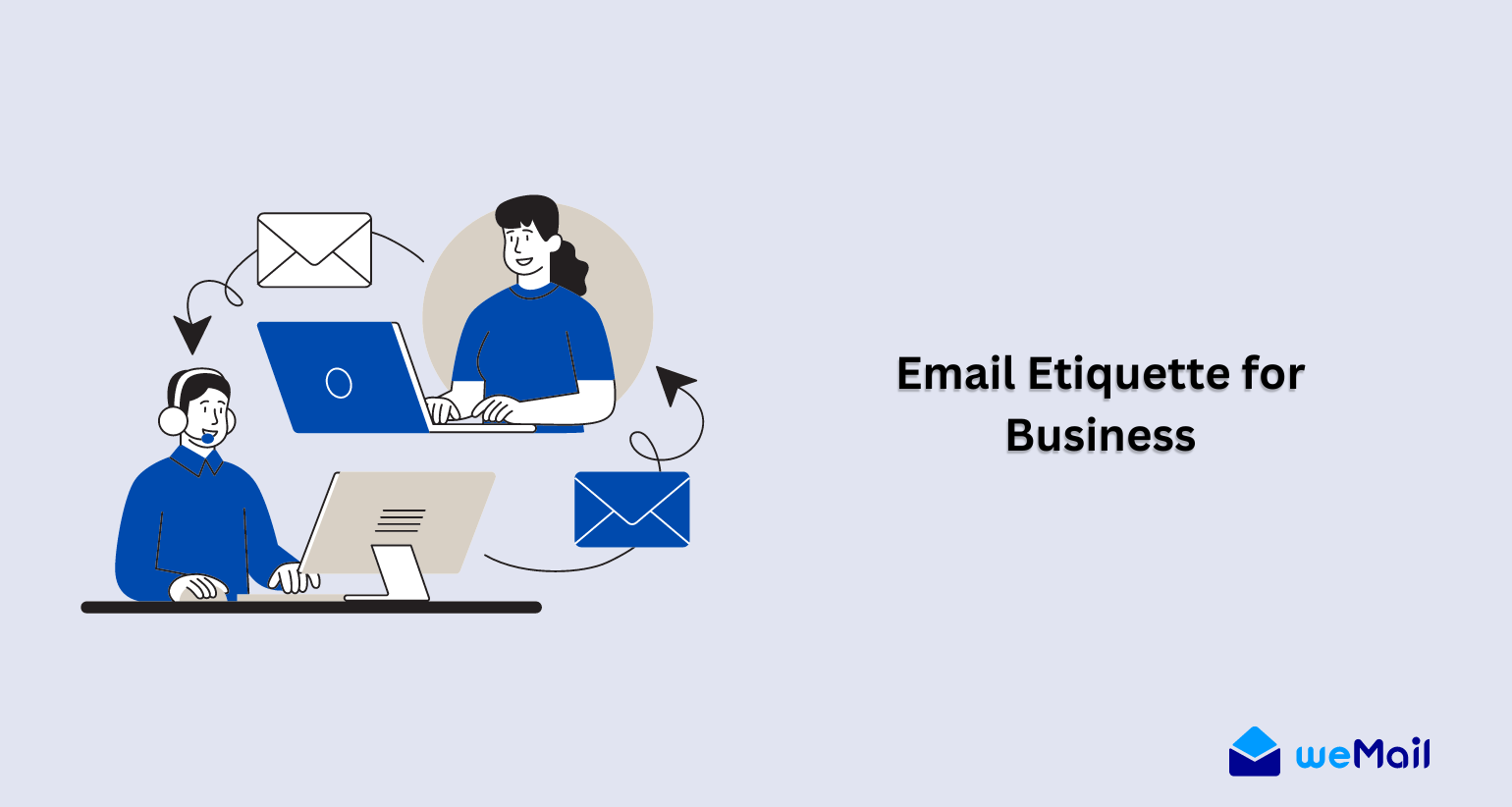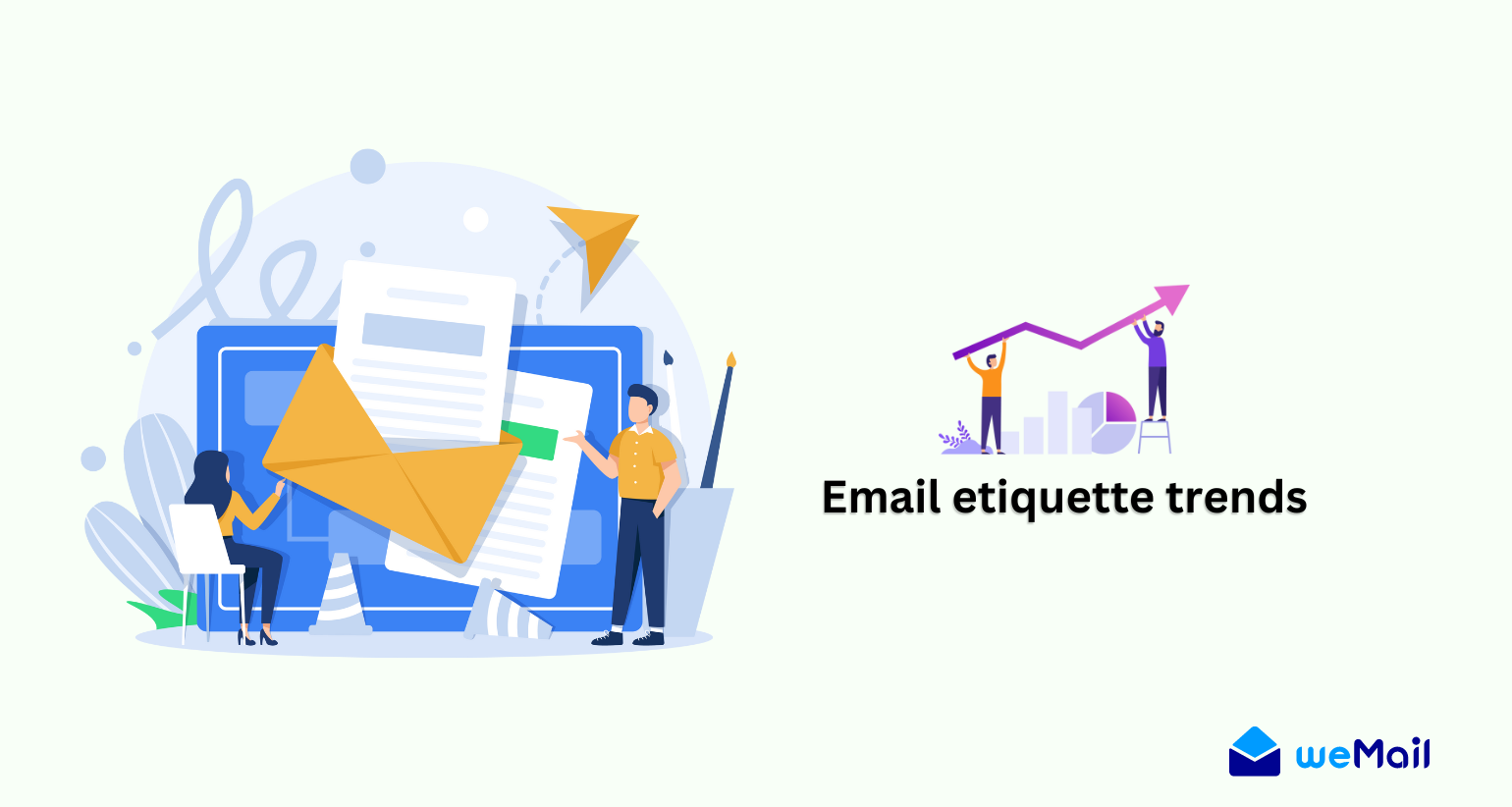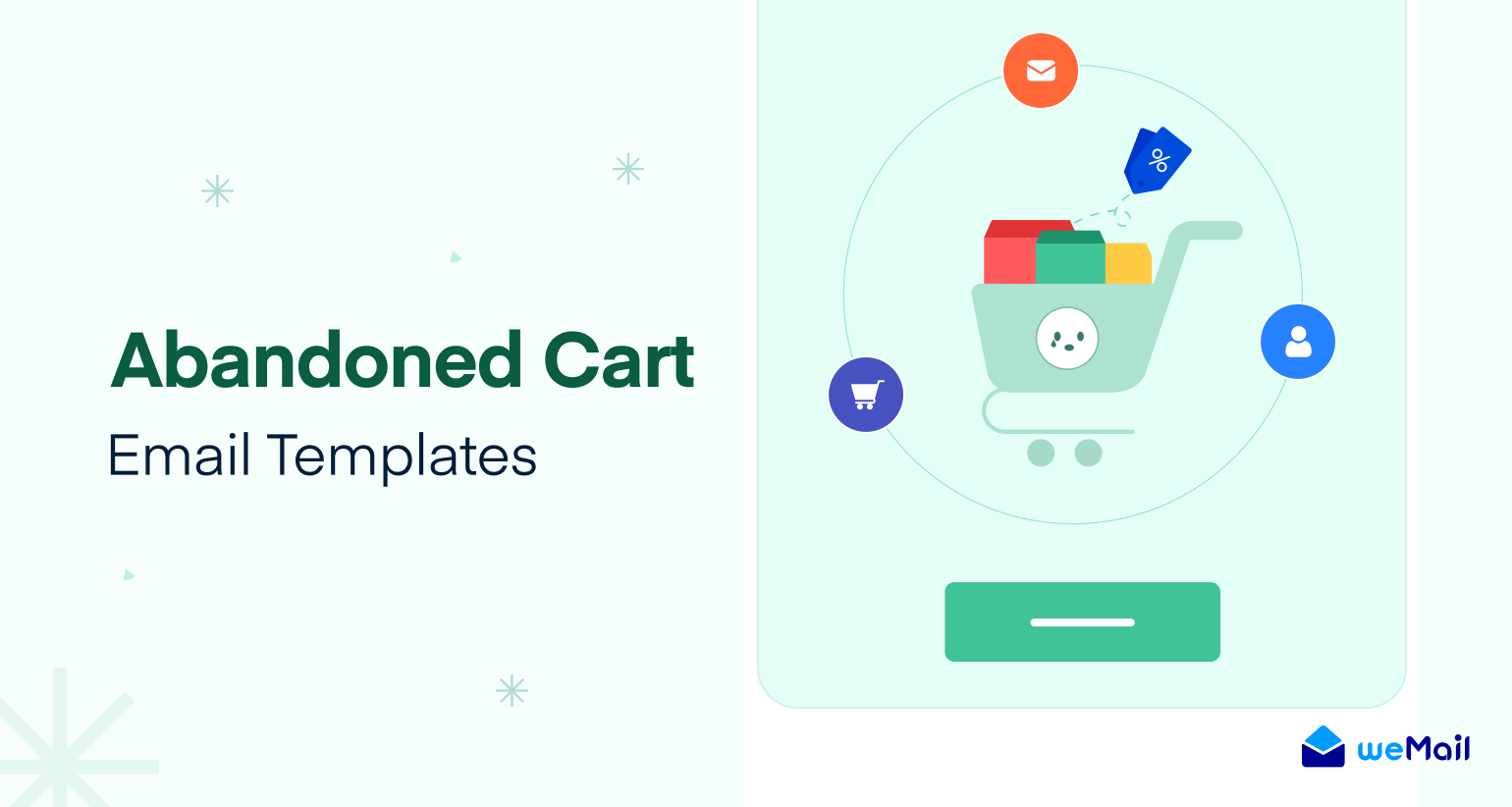Email Etiquette for Business: 10 Tips, Best Practices and Real-life Examples

Are you looking to make your email more professional to increase your email CTR and open rate? Using properly implemented email etiquette for business can trick the game and make a difference. In this blog, you will find helpful tips, best practices, and real-life examples to help make your next email campaign thriving.
Quick navigation
According to a GetResponse study, more than 80% of respondents indicated that email etiquette influenced their decision to engage with someone new. This means that crafting a professional email can significantly impact whether someone pays attention to you.
Therefore, companies must care about email etiquette to achieve the desired outcomes for their business. However, you might be wondering about email etiquette or the smart approach for better results in email marketing.
Let’s get started with the basic question first before we go deep into it:
What is email etiquette?

Simply put, etiquette is a set of rules or guides for polite behavior in different situations. It’s like a social game plan that helps us navigate interactions with others smoothly and respectfully.
When it comes to email marketing, it means using some proper communication channels to maintain professionalism with the recipient.
To conclude, email etiquette refers to using a professional format when sending emails to your recipient. It involves sending clear, professional, and respectful emails to your desired prospects.
Here are five important facts to understand the context of etiquette in email marketing.
- Imagine you’re meeting someone new. Use a proper email address (no nicknames or silly phrases).
- Give a quick preview of what your email is about. Think of it like a book title—it should be clear and attention-grabbing.
- Start with a hello (Dear Mr. or Mrs. Last Name is best for formal emails). End with a goodbye (Sincerely, Thanks, and best regards; all work well)
- Nobody wants a novel in their inbox. Get to the point in a friendly but professional way.
- Typos happen, but double-checking your email for mistakes shows you care and are professional.
Why is email etiquette important?
Whether you’re communicating with colleagues, clients, or other stakeholders, how you craft and handle your emails can leave lasting impressions. Proper email etiquette ensures these impressions are positive, promoting a professional image and facilitating effective communication.
There are no specific rules for applying etiquette to emails. It depends on the type of email and the recipients. However, you should follow some basic strategies if you want to achieve outcomes such as email click-through rates (CTR), open rates, conversions, or any other metrics you choose.
Now, let’s learn why following etiquette in email marketing is important for marketers.
1. Helps to maintain professionalism
Maintaining professionalism in emails reflects on the individual and the organization they represent. Well-structured, polite, and error-free emails convey competence and respect, which can enhance one’s professional image.
2. Sets clear communication benchmark
Proper email etiquette ensures that messages are clear and concise, reducing the likelihood of misunderstandings. This is especially important in business communications, where clarity can impact decision-making and productivity.
3. Good for time efficiency
Using proper etiquette can save time for both the sender and the recipient. Structured emails with a clear subject line, relevant content, and a specific call to action help recipients understand the message quickly and respond appropriately.
4. Builds a strong and long-lasting relationship
Emails that follow etiquette rules foster positive relationships. Being polite, using a professional tone, and responding promptly show respect for the recipient, which can strengthen professional and personal relationships.
5. Avoids misinterpretation
Emails lack the vocal tone and body language that are essential for conveying emotions and intentions. Adhering to etiquette guidelines, such as being polite and avoiding sarcasm, helps ensure the message is interpreted as intended.
6. Some legal considerations
In professional settings, emails can serve as official records of communication. Proper email etiquette ensures that these records are clear, respectful, and appropriate, which can be crucial in legal situations or audits.
10 email etiquette tips, best practices, and real-life examples

Now you know the basics of email etiquette, its importance, and other stuff. It’s time to explore the tips and tricks to make your email more professional and catchy. For that, we have presented a list of 15 etiquette tips for you.
If you’ve already implemented any one of them, thumbs up. If not, no worries; analyze your existing strategies with these and then tune up your new plans.
Let’s begin:
01. Prioritize your brand tone
Keeping a consistent brand tone is crucial for a company to grasp users’ attention and influence buying behavior. It’s a basic part of etiquette in email. However, if you have already adopted a standard tone like Big Brands does, it’s okay to continue.
80% of people believe proper email etiquette impacts their decision to engage with someone new.
Rescue Time
But for a new brand, you have to A/B test your brand tone using different methods. Once you find the pitch, implement it, and check the result sometimes.
Look at the email from All in SEO. They just used their usual brand tone. It’s a giveaway email for the users. Simple email. So, brand tone is important to let your users relate, connect, and finally purchase your digital products.

02. Must use a professional email address
What do you expect from an email marketing campaign? A long-term exposure or a short-term success. As a part of etiquette in email, using a professional email address is the key.
62.86% of business professionals prefer email communication over other methods, and a professional email address is a key factor in establishing trust
Fit Small Business
Along with trust, it helps to build:
1. First impression
Your email address is often the first thing a recipient sees. A professional email address creates a positive first impression and signals credibility.
Example:
- Before: [email protected]
- After: [email protected]
2. Proves that you maintain professionalism
A professional email address demonstrates that you take your professional image seriously. It reflects on both your brand and organization.
Example:
- Before: [email protected]
- After: [email protected]
3. A consistent flow
Using a company-specific email address ensures consistency in communication. It aligns with the company’s branding and makes it easier for recipients to identify your organization.
Example:
- Before: [email protected]
- After: [email protected]
3. Tell the short “TALK”
According to many sources, around 120 emails per day are the average for a general email user. In a sense, it’s a huge number. As a brand, you should not want your emails to go into the spam box, right?
Related read: Top Most Common Reasons Why Email Goes to Spam And How To Fix It – Part 1
We also have the second part, which resonates with why emails go to spam and ways to fix them. You can read that, too.
However, the main point is to use short sentences and space where required while focusing on the main context that you’re looking to deliver. For your help, let’s have a look at the below example from the ActiveCampaign email. It’s clean, short, and easily readable.

3. Tweak your “Subject Lines” with professionalism
Subject lines are the first thing that a user usually sees when they receive an email. All we can say is that it creates the first impression. Depending on your subject line, people will decide whether they should open it or not. We’re not saying this. Let’s check out the statistics below to confirm the statement.
64% of recipients decide to open or delete emails based on subject lines
HubSpot
The percentage shows how important subject lines are to higher email CTR. Therefore, as a part of etiquette, it’s also important for you to tweak your subject lines, A/B test different styles and tones to surprise users
Here is a guide for you to master etiquette using subject lines. We shared 13 best email subject line tips to increase your open rates and engagements. It will help you craft subject lines based on user preferences.
4. Double-check your grammar. It ‘happens’ you know
Another important thing to notice is to check your grammar before hitting the ‘Send Email‘ button. No matter how native writer or expert you are, mistakes will come automatically. Otherwise, there’s a high chance that you will miss some great opportunities.
Let’s see the stat below.
73.7% of respondents said they were less likely to do business with a company if they received an email with grammatical errors
Forbes
HubSpot shared some interesting things that every marketer should know.
- There/they’re/their
- Its/it’s
- Effect/affect
- Your/you’re
- Too/two/to
- Loose/lose
- I/me/myself
So, while writing anything important, like an email, you should know these terms to avoid silly mistakes. There are many ways to check grammar. You can use an online proofreading tool for accurate grammar correction. These tools help you catch errors easily and improve the clarity and quality of your writing.
However, you can check out the top 7 reasons email marketing doesn’t work.
5. Be yourself and let the signature reflect you
If you’re using Gmail, it has a feature to set email signatures depending on your role, designation, and other stuff. Have you already customized your email signature? If yes, it’s good. But it is important for those who have not used it yet.
Here’s an example of a signature. The email was sent from the Buffer team. Look at the signature. A simple profile picture and an end greeting with the name & role.

What else should you look for to make an email signature elegant and professional? Let’s find out below!
- Keep your signature concise and visually appealing.
- Tailor the information based on the context (internal vs. external communication).
- Update your signature regularly with any changes in contact details or promotions.
6. Follow-up smartly
Following up with customers is a good practice. The standard time frame for a follow-up email is 24 hours after you send the first email. It’s better to send at least three follow-up emails. In this regard, Yesware shared that:
Sales professionals who send one to three follow-up emails increase their reply rate by 18% compared to those who don’t follow up.
It seems that follow-up emails can increase email CTR if you can implement them in the right way. Now, how do you make that possible? Let’s follow the instructions:
- Be polite and professional.
- Start with a courteous reminder of your previous email.
- Keep it short and to the point.
- Restate the purpose of the initial email and why you are following up.
- Include any relevant attachments or links that might have been overlooked.
- Maintain a positive and respectful tone.
- Acknowledge that the recipient may be busy and thank them for their time.
7. Emojis are good but don’t overuse them
Emojis are good for expressing feelings in some cases. It resembles your current feelings and the way you want your recipients to feel the same. But overusing it can ruin all your efforts. Also, it can be marked as bad etiquette in email marketing.
A substantial portion of respondents (67%) believe emojis are not appropriate for business emails, and an even higher percentage (73%) consider GIFs and memes unprofessional
GetResponse
Now, what you’ll do if you’re an emoji lover? Here, you can follow these tips to smartly utilize emojis in email.
- Know your audience: Tailor your emojis to the recipient. For formal emails to colleagues, clients, or superiors, it’s best to limit or avoid emojis altogether. In informal communication or with people you know well, a few well-placed emojis can be appropriate.
- Consider the context: Is the email for serious business, a casual check-in, or congratulating someone? A lighthearted email allows for more emojis than a formal request or presenting sensitive information.
- Start small and subtle: If you’re unsure, err on the side of caution. Use just one or two emojis to add a touch of personality without going overboard.
- Focus on clarity: The primary function of an email is to communicate clearly. Don’t rely on emojis to convey the entire message. Use them to enhance your tone or add emphasis, not replace words.
- Think about the tone: Emojis can be subjective. A thumbs up () might seem positive, but a thumbs down () could be interpreted as harsh. Choose emojis that accurately reflect the intended tone.
- Consider alternatives: Emojis aren’t the only way to add personality. You can use descriptive language, humour (carefully!), or a friendly closing to achieve a similar effect.
8. Never misspell your ‘Recipient’s’ name
Suppose your name is ‘Michale‘ and you got an email from your favourite brand. It’s like, Hey ‘Michel‘, hope you’re doing great. How will it feel? Obviously, it feels bad when someone misspells or calls your name incorrectly. The same is the case for the recipients.

From the above example, we can come to the point that:
- Use the recipient’s preferred name and verify the spelling
- Place the name strategically in the greeting and body
- Use it naturally and contextually
- Tailor formality based on relationship and culture
- Personalize your closing, avoid overuse, and combine your name with personalized content and references.
9. Be careful of using the correct ‘FONT’ and ‘Formatting’
The right fonts and formatting ensure your email is easy to read for a wide audience. This includes using fonts that are clear and large enough on various devices, with proper spacing and line breaks to avoid overwhelming text blocks. Poor readability can lead to people losing interest or simply not being able to understand your message.
Apart from that, a consistent brand font and format will help you create a buzz in your users’ minds. Here are some other facts that resonate with why it’s crucial to maintain.
- It helps to maintain professionalism and brand identity
- Has an impact on user engagement
- Increases the emotional response
If you want to implement these, here is a detailed breakdown that might help you.
- Font choice: Opt for clear, professional fonts like Arial, Helvetica, or Georgia. Avoid decorative or difficult-to-read fonts.
- Font size: Use a font size that’s easy to read on desktops and mobile devices (around 14-16 px is a good starting point).
- Line spacing and padding: Leave enough space between lines and paragraphs to avoid a cluttered look.
- Alignment: Left alignment is standard for email content, but you can use centering for headings or CTAs.
- Color contrast: Ensure good color contrast between text and background for readability. Black text on a white background is a safe bet.

10. Proofread and double proofread
There is no alternative to proofread content after it’s finished. The more you take a closer look at it, the better you fine-tune it. Every time, you’ll find new scopes to update and upgrade. If you’re unable to do that, get help from your co-workers or partners to check it thoroughly.
Also, you can check your email copy by using different available AI tools. The main purpose is to make your write-up 100% error-free.
Related read: How to Write a Friendly Email for Email Marketing
These are the top 10 email etiquette tips that you need to learn, apply, and execute to bring the desired outcomes for your business. So what’s the bottom line? Let’s recap once again.
- Prioritize your brand tone
- Use a professional email address
- Tweak your “Subject Lines”
- Double-check your grammar
- Use your own email signature
- Follow-up smartly
- Don’t overuse emojis
- Never mispel your “Recipient’s” name,
- Use the correct “FONT” and “Formatting”,
- Proofread and double proofread
Must-know email marketing etiquette trends to follow

Staying updated with email etiquette trends ensures your communication remains effective and professional. Here are the top six trends for 2024, along with detailed explanations and real-world examples.
01. The best use of concise subject lines
Short, specific subject lines help recipients quickly understand the purpose of the email. They should be clear and to the point, avoiding unnecessary words. This increases the chances of the email being opened and read promptly.

02. Personalization at its best
Tailoring emails to the recipient’s preferences and context shows that you value them. Personalization can include using their name, referencing previous interactions, or customizing content based on their interests. This approach makes the recipient feel valued and understood, increasing engagement.

03. Smart use of language
Using inclusive language ensures that your emails are respectful and considerate of all recipients. This includes avoiding gender-specific terms and using language that respects diversity. Inclusive language promotes a positive and respectful tone, which is essential for diverse workplaces.

04. Elegant use of visual elements
Incorporating visuals such as images, GIFs, and infographics can make your emails more engaging and easier to understand. Visuals help break up text and can highlight key information effectively. They cater to visual learners and can make complex information more digestible.

05. Mobile optimization should be at its best
With many people accessing emails on mobile devices, ensuring your emails are mobile-friendly is crucial. This includes using responsive design, readable fonts, and easily clickable links. Mobile optimization ensures that your email is easy to read and interact with on any device.
06. Clear Call-to-Action (CTA)
Including a specific and clear call-to-action in your emails directs recipients to what steps to take next. A well-defined CTA increases the likelihood of a desired response. It should be prominent and action-oriented, guiding the recipient towards the next step.

Types of email etiquette
Email etiquette contains various practices that ensure your email communication is professional, clear, and effective. These practices help in enabling better relationships, maintaining professionalism, and ensuring efficient communication.
Here are the main types of email etiquette:
1. Professional etiquette
Professional etiquette involves maintaining a formal tone, using appropriate greetings and closings, and respectful language. This type of etiquette is crucial in business environments where maintaining a professional image is essential.
Key things to look for:
- Use formal greetings and closings (e.g., “Dear Mr. Smith,” “Best regards,”).
- Avoid slang, jargon, and overly casual language.
- Ensure your email address and signature are professional.
2. Communication etiquette
This focuses on the clarity and effectiveness of the message. It involves being concise, using proper grammar, and organizing the content logically. Clear communication prevents misunderstandings and ensures the recipient understands the message.
Key things to look at:
- Write clear and specific subject lines.
- Use short paragraphs, bullet points, and headings for readability.
- Proofread for spelling and grammar errors before sending.
3. Responsive etiquette
This type involves timely responses and proper follow-up. It shows respect for the recipient’s time and helps maintain a smooth flow of communication. Prompt responses also convey professionalism and reliability.
Key things to look at:
- Acknowledge receipt of important emails promptly.
- Follow up on unanswered emails within a reasonable time frame.
- Use out-of-office replies when necessary.
4. Security etiquette
Ensuring the privacy and security of information shared via email is crucial, especially when dealing with sensitive data. This type of etiquette is vital to protecting both personal and organizational information.
Key things to look at:
- Use encryption for sensitive information.
- Verify email addresses before sending confidential information.
- Avoid sharing passwords and sensitive data over email.
5. Cultural etiquette
This involves being aware of and respectful of the cultural norms and practices of your recipients, especially in international communication. Understanding cultural differences can prevent miscommunication and foster better relationships.
Key things to look at:
- Avoid idiomatic expressions and culturally specific references.
- Be mindful of time zones and holidays.
- Use respectful titles and honorifics.
6. Legal etiquette
Legal etiquette involves adhering to laws and regulations related to email communication, such as GDPR or CAN-SPAM. Compliance with these regulations is crucial to avoid legal issues and maintain trust.
Key things to look at:
- Include unsubscribe links in marketing emails.
- Ensure proper disclosure of information.
- Keep records of important email communications.
Final thoughts
Whatever you do (your business), your success solely depends on your approach, strategy, and proper implementation. As a part of a vital marketing strategy, email marketing is most likely the crucial aspect of online marketing.
Still, many of the marketers think that email marketing is dead or not worth spending on it. If you’re one of them, look at the statistics below:
- High ROI: Email marketing boasts a significant return on investment (ROI). Studies show an average ROI of around 4200%, meaning for every $1 spent, you can expect a return of $42
- User Base Growth: The number of email users continues to grow globally. Estimates suggest there will be over 4.8 billion email users by 2027.
- Customer Preference: Many consumers still prefer email communication from brands. A study by OptinMonster revealed that 60% of consumers had made a purchase directly from an email.
- Open Rates: While open rates can vary depending on industry and campaign specifics, the average open rate for marketing emails is around 20-30%.
Therefore, if you’re still not following the standard email etiquette for your marketing, it’s high time that you should look at the stats and implement them today.
We hope this marketing guide helps you learn something new and interesting. For more marketing guides, tutorials, industry updates, and news regarding email marketing, subscribe to our newsletter to get time-to-time updates.



